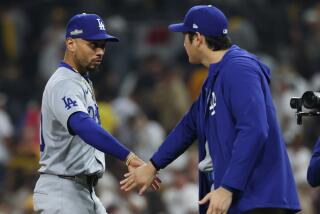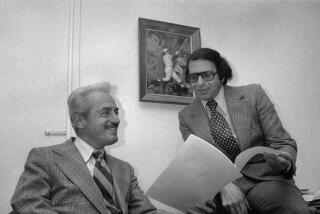In Baseball, Union Retains Its Clout
Across the country, peanuts and Cracker Jack will be served today. Fresh lines of chalk will separate the field of play from foul territory. And the national anthem will blare out of loudspeakers as hundreds of thousands of fans sing along.
The Major League Baseball Players Assn. may have helped save the remainder of the 2002 season by agreeing to increased revenue sharing and a luxury tax, but it retains its clout as one of the nation’s most powerful brotherhoods, capable of bringing the 126-year-old national pastime to a halt.
“Clearly they’re the most successful union in post-World War II America, if you measure success by the enormous gains it’s made for its members,” said Chuck Korr, a professor of history at the University of Missouri at St. Louis who recently published a book on baseball’s labor history.
The union’s strength is drawn in part from skilled leadership from veterans of the United Steelworkers of America union and an unusual degree of cohesiveness among the ranks, a unique formula that makes the most of collective bargaining. It also helps that the game’s superstars have shown an unparalleled willingness to put their astronomical salaries on the line and go to bat for their brethren at the bottom of the pay scale.
Since the union’s early days, minimum player salaries have increased from $13,500 to $200,000. Average salaries have skyrocketed from $24,909 in 1969 to $2.34 million. Players have prevailed in each of the eight work stoppages since 1972.
That record of success makes the players union the envy of the U.S. labor movement. Nationwide, the proportion of workers represented by unions has dropped from one in three in 1955 to one in eight today.
A full assessment on how well the players union fared in Friday’s agreement won’t be possible for several years.
“I don’t think [Friday’s deal] says anything at all about the strength of either side,” said Leonard Koppett, a member of the writers wing of the Baseball Hall of Fame and author of “Koppett’s Concise History of Major League Baseball.” “If it turns out to be very disadvantageous to one side or the other, then we’ll be able to say somebody lost.”
Korr said both sides were able to prevail by avoiding a potential devastating strike. The union “got what was acceptable to them at no cost. I don’t see how anybody can call that losing.”
Relations between the union and the team owners weren’t always adversarial. In its early days, the Major League Baseball Players Assn. acted more as an advisor than an adversary. When it was formed in 1954, its main purpose was to allow players to work with team owners in administering the players’ pension fund.
(The first attempt by players to organize came as early as 1885, but owners were able to suppress that and several subsequent attempts.)
The climate changed by 1965, when five veteran players--including 19-game winner Jim Bunning of the Philadelphia Phillies--began searching for a strong leader.
“Baseball was increasingly turning to corporate ownership--CBS had bought the Yankees--and we knew we needed representation,” said Bunning, now a Republican senator from Kentucky.
In 1966, the players found it in Marvin Miller, chief economic advisor for the United Steelworkers of America, and Dick Moss, the union’s associate general counsel. Miller became executive director of the Major League Baseball Players Assn. and Moss its general counsel.
“We started working in some pretty primitive times,” Moss said. “The minimum major league salary was $6,000, and had been for 20 years. The spring training allowance was $25 a week, and had been for 20 years.”
In just one year, Miller and Moss persuaded team owners to double the minimum salary to $12,000. But Moss was amazed by the lack of respect the owners had for players.
“The owners’ most frequent line to the players was, ‘If you don’t like it, go find something else to do,’ ” Moss said. “In some cases, they’d tell the white player, ‘Go drive a truck,’ and if it was a black player, it was, ‘Go pick cotton.’ ”
That attitude only helped foster solidarity among players.
In 1969, the union won the right for players to seek an independent arbitrator to settle their grievances. It proved a critical breakthrough for the union because it allowed players to break free from the major instrument of their angst--the reserve clause, which allowed team owners to unilaterally renew a player’s contract year after year. The only stipulation was that the player’s salary couldn’t be cut by more than 20%.
St. Louis Cardinals outfielder Curt Flood challenged the reserve clause in 1970 by filing a $4.1-million antitrust lawsuit against Major League Baseball. The players union backed him.
“He claimed [baseball owners] were in violation of antitrust laws by denying him the right to seek gainful employment where he wanted,” Korr said. “He lost at every level, but he energized the players. He turned it into an ‘us’ versus ‘them’ situation.”
So in 1972, when team owners tried to reduce their payment to the players pension fund by $500,000, the players decided to fight back.
That first strike lasted about a week, wiping out 60 to 80 games.
“The owners settled by giving the players everything they asked for,” Korr said. “It showed the players they could win.”
The players won another important battle in 1973 when they gained the right to seek raises from an independent arbitrator, and then free agency in 1976. The victories would help pave the way for competition between teams and ultimately led to today’s multimillion-dollar salaries.
“With arbitration and free agency, the baseball players have dealt from a position of strength,” said Richard Berthelsen, general counsel of the NFL Players Assn. “Every subsequent bargaining has been about what, if anything, will the players give back? That’s why they always win.”
In 1994, owners tried to do away with the free-agent bidding system and salary arbitration. Players responded by going on strike, a 232-day ordeal that resulted in the cancellation of the World Series. As usual, they prevailed. The National Labor Relations Board ruled the owners were committing unfair labor practices, and a federal judge ordered them to restore free-agent bidding and salary arbitration.
“The strikes have never been over something the players wanted,” Koppett said. “It has always been to prevent the owners from taking away something the players have. In wars--and these labor things are wars--the country that’s defending its homeland always has an advantage over the invader.”
This dispute was different. Players had agreed to a system that included revenue sharing and a luxury tax in their last contract. This time, the sides were haggling over the numbers that would be attached to such a system. That kind of disagreement is easier to resolve.
“The basic factor here is there is no philosophical war,” said Bill Gould, a labor law professor at Stanford Law School and former chairman of the National Labor Relations Board. “There is just a question of dollars and cents.”
More to Read
Go beyond the scoreboard
Get the latest on L.A.'s teams in the daily Sports Report newsletter.
You may occasionally receive promotional content from the Los Angeles Times.












